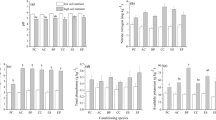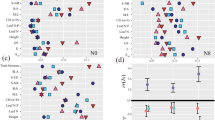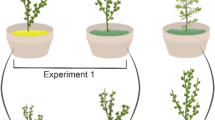Abstract
Background and Aims
Semi-natural grasslands can combine biomass production with provision of multiple ecosystem services. Unfortunately, grassland establishment can be unpredictable and vulnerable to exotic plant invasion, potentially due to soil legacies from previous cultivation. Native plants could mitigate these legacies by changing soil attributes and facilitating other native grassland species. However, facilitation may be affected by nitrogen (N) fertilization, added during and after establishment.
Methods
We conditioned soils in a former maize-soybean field for 3 years using multiple native or exotic perennial species or a maize-soybean rotation. Half of each plot received N fertilizer. Native and exotic grassland perennials were grown on these conditioned soils in the greenhouse, with N added to half of the pots, and biomass was measured.
Results
Consistent facilitation of native species by other natives was not observed, nor did invasive species facilitate other invasives. Soil conditioning affected individual plant species’ biomass in several instances. Field N addition had little effect on plant biomass, while greenhouse N addition increased native more than exotic plant biomass, but did not alter the overall pattern of facilitation.
Conclusions
Native plants failed to facilitate native prairie establishment in this work, suggesting resistance to conditioning on former intensive, high-input agricultural soils.




Similar content being viewed by others
References
Adl SM, Coleman DC, Read F (2006) Slow recovery of soil biodiversity in sandy loam soils of Georgia after 25 years of no-tillage management. Agric Ecosyst Environ 114:323–334
Allison S (2011) The paradox of invasive species in ecological restoration: do restorationists worry about them too much or too little? In: Rotherham I, Lambert R (eds) Invasive and introduced plants and animals. Human perceptions, attitudes and approaches to management. Earthscan, Oxford, pp 265–275
Baxendale C, Orwin KH, Poly F, Pommier T, Bardgett RD (2014) Are plant-soil feedback responses explained by plant traits? New Phytol 204:408–423
Bever JD (2002) Negative feedback within a mutualism: host-specific growth of mycorrhizal fungi reduces plant benefit. Proc Biol Sci 269:2595–2601
Bever JD, Platt TG, Morton ER (2012) Microbial population and community dynamics on plant roots and their feedbacks on plant communities. Annu Rev Microbiol 66:265–283
Blank RR (2010) Intraspecific and interspecific pair-wise seedling competition between exotic annual grasses and native perennials: plant–soil relationships. Plant Soil 326:331–343
Boody G, Vondracek B, Andow DA, Vondracek B, Andow DA, Krinke M, Westra J, Zimmerman J, Welle P (2005) Multifunctional agriculture in the United States. Bioscience 55:27–38
Brookes PG, Landman A, Pruden G, Jenkinson DS (1985) Chloroform fumigation and the release of soil nitrogen: a rapid direct extraction method to measure microbial biomass nitrogen in soil. Soil Biol Biochem 17:837–842
Buckley DH, Schmidt TM (2001) The structure of microbial communities in soil and the lasting impact of cultivation. Microb Ecol 42:11–21
Buckley DH, Schmidt TM (2003) Diversity and dynamics of microbial communities in soils from agro-ecosystems. Environ Microbiol 5:441–442
Callaway RM, Lawrence RW (1997) Competition and faciliation: a synthetic approach to interactions in plant communities. Ecology 78:1958–1965
Callaway RM, Thelen GC, Rodriguez A, Holben WE (2004) Soil biota and exotic plant invasion. Nature 427:731–733
Casper BB, Castelli JP (2007) Evaluating plant-soil feedback together with competition in a serpentine grassland. Ecol Lett 10:394–400
Castelli JP, Casper BB (2003) Intraspecific AM fungal variation contributes to plant–fungal feedback in a serpentine grassland. Ecology 84:323–336
Chen P-C, Phillips DA (1977) Induction of root nodule senescence by combined nitrogen in Pisum sativum L. Plant Physiol 59:440–442
Corbin JD, D’Antonio CM (2012) Gone but Not Forgotten? Invasive plants’ legacies on community and ecosystem properties. Invasive Plant Sci Manag 5:117–124
Corkidi L, Rowland DL, Johnson NC, Allen EB (2002) Nitrogen fertilization alters the functioning of arbuscular mycorrhizas at two semiarid grasslands. Plant Soil 240:299–310
D’Antonio CM, Vitousek PM (1992) Biological invasions by exotic grasses, the grass/fire cycle, and global change. Annu Rev Ecol Syst 23:63–87
Egerton-Warburton LM, Graham RC, Allen EB, Allen MF (2001) Reconstruction of the historical changes in mycorrhizal fungal communities under anthropogenic nitrogen deposition. Proc Biol Sci 268:2479–2484
Egerton-Warburton LM, Johnson NC, Allen EB (2007) Mycorrhizal community dynamics following nitrogen fertilization: a cross-site test in five grasslands. Ecol Monogr 77:527–544
Ehrenfeld JG (2003) Effects of exotic plant invasions on soil nutrient cycling processes. Ecosystems 6:503–523
Ehrenfeld J, Ravit B, Elgersma K (2005) Feedback in the plant-soil system. Annu Rev Environ Resour 30:75–115
Elgersma KJ, Ehrenfeld JG, Yu S, Vor T (2011) Legacy effects overwhelm the short-term effects of exotic plant invasion and restoration on soil microbial community structure, enzyme activities, and nitrogen cycling. Oecologia 167:733–745
Eviner V, Hawkes C (2012) The effects of plant-soil feedbacks on invasive plants: Mechanisms and potential management options. In: Monaco TA, Sheley RA (eds) Invasive plant ecology and management: linking processes to practice Cabi Invasives Series Volume 2. CABI Publishing, Boston, pp 122–141
Felice L, Jordan NR, Dill-Macky R, Sheaffer CC, Aldrich-Wolfe L, Huerd SC, Kinkel LL (2015) Soil Streptomyces communities in a prairie establishment reflect interactions between soil edaphic characteristics and plant host. Plant Soil 386:89–98
Fitzsimons MS, Miller RM (2010) The importance of soil microorganisms for maintaining diverse plant communities in tallgrass prairie. Am J Bot 97:1937–1943
Fletcher RJ, Robertson BA, Evans J, Doran PJ, Alavalapati JRR, Schemske DW (2011) Biodiversity conservation in the era of biofuels: risks and opportunities. Front Ecol Environ 9:161–168
Frank K, Beagle D, Denning J (1998) Chapter 6 Phosphorus. In Recommended Chemical Soil Test Procedures for the North Central Region. North Central Regional Publication No. 221 (Revised). Missouri Agricultural Experiment Station SB 1001, pp 21–29
Gardiner MA, Tuell JK, Isaacs R, Gibbs J, Ascher JS, Landis DA (2010) Implication of three biofuel crops for beneficial arthropods in agricultural landscapes. Bioenergy Res 3:6–19
Gröm** U (2006) Relative importance for linear regression in R: the package relaimpo. J Stat Softw 17:1–27
Hector A, Bagchi R (2007) Biodiversity and ecosystem multifunctionality. Nature 448:188–190
Hejda M, Pyšek P, Jarošík V (2009) Impact of invasive plants on the species richness, diversity and composition of invaded communities. J Ecol 97:393–403
Henriksen A, Selmer-Olsen AR (1970) Automatic methods for determining nitrate and nitrite in water and soil extracts. Analyst 95:514–518
Hillhouse HL, Zedler PH (2011) Native species establishment in tallgrass prairie plantings. Am Midl Nat 166:292–308
Hirsch PR (1996) Population dynamics of indigenous and genetically modified rhizobia in the field. New Phytol 133:159–171
Hol WHG, de Boer W, ten Hooven F, van der Putten WH (2013) Competition increases sensitivity of wheat (Triticum aestivum) to biotic plant-soil feedback. PLoS One 8, e66085
Inderjit, van der Putten WH (2010) Impacts of soil microbial communities on exotic plant invasions. Trends Ecol Evol 25:512–519
Isbell F, Calcagno V, Hector A et al (2011) High plant diversity is needed to maintain ecosystem services. Nature 477:199–202
Jarchow ME, Liebman M, Rawat V, Anex RP (2012) Functional group and fertilization affect the composition and bioenergy yields of prairie plants. GCB Bioenergy 4:671–679
Jiang L, Han X, Zhang G, Kardol P (2010) The role of plant–soil feedbacks and land-use legacies in restoration of a temperate steppe in northern China. Ecol Res 25:1101–1111
Johnson N, Rowland D, Corkidi L, Egerton-Warburton LM, Allen EB (2003) Nitrogen enrichment alters mycorrhizal allocation at five mesic to semiarid grasslands. Ecology 84:1895–1908
Jordan NR, Larson DL, Huerd SC (2008) Soil modification by invasive plants: effects on native and invasive species of mixed-grass prairies. Biol Invasions 10:177–190
Jordan NR, Larson DL, Huerd SC (2011) Evidence of qualitative differences between soil-occupancy effects of invasive vs. native grassland plant species. Invasive Plant Sci Manag 4:11–21
Jordan NR, Aldrich-Wolfe L, Huerd SC, Larson DL, Muehlbauer L (2012) Soil-occupancy effects of invasive and native grassland plant species on composition and diversity of mycorrhizal associations. Invasive Plant Sci Manag 5:494–505
Kaiser DE, Lamb JA, Eliason R (2011) Fertilizer recommendations for agronomic crops in Minnesota. BU-06240-S. Univ. of Minnesota Ext, St. Paul, www.extension.umn.edu/agriculture/nutrient-management/nutrient-lime-guidelines/fertilizer-recommendations-for-agronomic-crops-in-minnesota/
Kardol P, Bezemer MT, Van Der Putten WH (2006) Temporal variation in plant-soil feedback controls succession. Ecol Lett 9:1080–1088
Keeney DR, Nelson DW (1982) Nitrogen-Inorganic Forms. Method 33–3.2. In: Page AL (ed) Methods of soil analysis. Part 2 chemical and microbiological properties, 2nd edn. ASA, SSA, Madison, pp 643–698
Klironomos J (2002) Feedback with soil biota contributes to plant rarity and invasiveness in communities. Nature 417:67–70
Kulmatiski A (2006) Exotic plants establish persistent communities. Plant Ecol 187:261–275
Kulmatiski A, Beard KH (2008) Decoupling plant-growth from land-use legacies in soil microbial communities. Soil Biol Biochem 40:1059–1068
Kulmatiski A, Beard KH, Stark JM (2006) Soil history as a primary control on plant invasion in abandoned agricultural fields. J Appl Ecol 43:868–876
Kulmatiski A, Beard KH, Stevens JR, Cobbold SM (2008) Plant-soil feedbacks: a meta-analytical review. Ecol Lett 11:980–992
Kuznetsova A, Brockhoff PB, Christensen RHB (2014) lmerTest: tests for random and fixed effects for linear mixed effect models (lmer objects of lme4 package). R package version 2.0-11. http://CRAN.R-project.org/package=lmerTest
Lowe PN, Lauenroth WK, Burke IC (2002) Effects of nitrogen availability on the growth of native grasses exotic weeds. J Rangel Manag 55:94–98
Manning P, Morrison SA, Bonkowski M, Bardgett RD (2008) Nitrogen enrichment modifies plant community structure via changes to plant-soil feedback. Oecologia 157:661–673
Marler M, Zabinski C, Callaway R (1999) Mycorrhizae indirectly enhance competitive effects of an invasive forb on a native bunchgrass. Ecology 80:1180–1186
Matson PA, Parton WJ, Power AG, Swift MJ (1997) Agricultural intensification and ecosystem properties. Science 277:504–509
Morris L (2012) Land-use legacy effects of cultivation on ecological processes. In: Monaco TA, Shelley RA (eds) Invasive plant ecology and management: linking processes to practice (Cabi Invasives Series). CABI Publishing, pp 35–56
Naeem S, Håkansson K, Lawton JH et al (1996) Biodiversity and plant productivity in a model assemblage of plant species. Oikos 76:259–264
Nichols VA, Miguez FE, Jarchow ME et al (2014) Comparison of cellulosic ethanol yields from midwestern maize and reconstructed tallgrass prairie systems managed for bioenergy. BioEnergy Res:1550–1560
Noyd RK, Pfleger FL, Russelle MP (1995) Interactions between native prairie grasses and indigenous arbuscular mycorrhizal fungi: implications for reclamation of taconite iron ore tailing. New Phytol 129:651–660
Nutman P (1956) The influence of the legume in root-nodule symbiosis. Biol Rev 31:109–151
Oehl F, Sieverding E, Ineichen K, Mäder P, Boller T, Wiemken A (2003) Impact of land use intensity on the species diversity of arbuscular mycorrhizal fungi in agroecosystems of Central Europe. Appl Environ Microbiol 69:2816–2824
Ortega YK, Pearson DE (2005) Weak vs. strong invaders of natural plant communities: assessing invasibility and impact. Ecol Appl 15:651–661
Perkins LB, Nowak RS (2012) Soil conditioning and plant–soil feedbacks affect competitive relationships between native and invasive grasses. Plant Ecol 213:1337–1344
Perkins LB, Nowak RS (2013) Native and non-native grasses generate common types of plant-soil feedbacks by altering soil nutrients and microbial communities. Oikos 122:199–208
R Core Team (2013) R: A language and environment for statistical computing. R Foundation for Statistical Computing, Vienna, URL: http://www.R-project.org/
Reinhart KO, Callaway RM (2006) Soil biota and invasive plants. New Phytol 170:445–457
Rothrock P, Squiers E (2003) Early succession in a tallgrass prairie restoration and the effects of nitrogen, phosphorus, and micronutrient enrichments. Proc Indiana Acad Sci 112:160–168
Schulte LA, Liebman M, Asbjornsen H, Crow TR (2006) Agroecosystem restoration through strategic integration of perennials. J Soil Water Conserv 61:164–169
Shannon S, Flory SL, Reynolds H (2012) Competitive context alters plant-soil feedback in an experimental woodland community. Oecologia 169:235–243
Smith LM, Reynolds HL (2012) Positive plant-soil feedback may drive dominance of a woodland invader, Euonymus fortunei. Plant Ecol 213:853–860
Steenwerth KL (2003) Soil microbial community composition and land use history in cultivated and grassland ecosystems of coastal California. Soil Biol Biochem 35:489–500
Suding KN, Stanley Harpole W, Fukami T, Kulmatiski A, MacDougall AS, Stein C, van der Putten WH (2013) Consequences of plant-soil feedbacks in invasion. J Ecol 101:298–308
Tilman D, Reich PB, Knops JMH (2006) Biodiversity and ecosystem stability in a decade-long grassland experiment. Nature 441:629–632
Török P, Miglécz T, Valkó O, Kelemen A, Deák B, Lengyel S, Tóthmérész B (2012) Recovery of native grass biodiversity by sowing on former croplands: Is weed suppression a feasible goal for grassland restoration? J Nat Conserv 20:41–48
U.S. Department of Energy (2011) Chapter 2 Biomass in current and projected energy consumption. In: Perlack RD, Stokes BJ (eds) U.S. Billion-Ton Update: Biomass supply for a bioenergy and bioproducts industry. ORNL/TM-2011/224. Oak Ridge National Laboratory, Oak Ridge, pp 7–15
Vance ED, Brookes PC, Jenkinson DS (1987) An extraction method for measuring soil microbial biomass C. Soil Biol Biochem 19:703–707
Venables WN, Ripley BD (2002) Modern applied statistics with S. Springer, New York
Vinton MA, Goergen EM (2006) Plant–soil feedbacks contribute to the persistence of Bromus inermis in tallgrass prairie. Ecosystems 9:967–976
Warncke D, Brown JR (1998) Chapter 7 Potassium and other basic cations. in recommended chemical soil test procedures for the North Central Region. North Central Regional Publication No. 221 (Revised). Missouri Agric Exp Station SB 1001:21–29
Watson ME, Brown JR (1998) Chapter 4 pH and lime requirement. In recommended chemical soil test procedures for the North Central Region. North Central Regional Publication No. 221 (Revised). Missouri Agric Exp Station SB 1001:21–29
Wilcove DS, Rothstein D, Dubow J et al (1998) Quantifying threats to imperiled species in the United States. Bioscience 48:607–615
Williams CL, Charland P, Radloff G, Sample D, Jackson RD (2013) Grass-shed: place and process for catalyzing perennial grass bioeconomies and their potential multiple benefits. J Soil Water Conserv 68:141A–146A
Wilson GWT, Hartnett DC (1998) Interspecific variation in plant responses to mycorrhizal colonization in tallgrass prairie. Am J Bot 85:1732–1738
Zavaleta ES, Pasari JR, Hulvey KB, Tilman GD (2010) Sustaining multiple ecosystem functions in grassland communities requires higher biodiversity. Proc Natl Acad Sci U S A 107:1443–1446
Zhou X, **ao B, Ochieng RM, Yang J (2009) Utilization of carbon-negative biofuels from low-input high-diversity grassland biomass for energy in China. Renew Sustain Energy Rev 13:479–485
Zuur A, Ieno E, Smith G (2007) Introduction to mixed modelling. In: Analysing ecological data. Springer, New York, pp 125–142
Acknowledgments
We thank our field, lab and greenhouse assistants; M. Bezener at the UMN Statistical Consulting Service for statistical advice; J. Larson for agricultural advice; L. Felice for significant contributions to our research and review of this manuscript and two anonymous referees for helpful suggestions on improving the manuscript.
This work was supported by Agriculture and Food Research Initiative grant nr 2010-85320-20565 from the United States Department of Agriculture.
Author information
Authors and Affiliations
Corresponding author
Additional information
Responsible Editor: Gera Hol .
Electronic supplementary material
Below is the link to the electronic supplementary material.
ESM 1
(DOCX 438 kb)
Rights and permissions
About this article
Cite this article
Vink, S.N., Jordan, N.R., Huerd, S.C. et al. Soil conditioning effects of native and exotic grassland perennials on the establishment of native and exotic plants. Plant Soil 393, 335–349 (2015). https://doi.org/10.1007/s11104-015-2498-1
Received:
Accepted:
Published:
Issue Date:
DOI: https://doi.org/10.1007/s11104-015-2498-1




